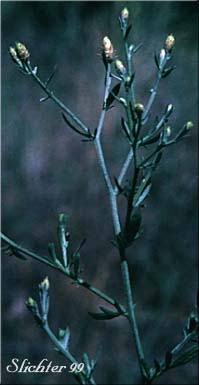 The
photo at right shows the branching form of Centaurea diffusa from the airport
at the Dallesport, WA.......June 26, 1991. Note the open branching of the
stiff stems.
The
photo at right shows the branching form of Centaurea diffusa from the airport
at the Dallesport, WA.......June 26, 1991. Note the open branching of the
stiff stems.
Tumble knapweed is an erect, widely branched annual or biennial from 10-60 cm tall. The pinnatifid leaves are small. The leaves are reduced in size upwards on the stem, becoming entire in the inflorescence.
The numerous flower heads are narrow, with the involucre 8-10 mm tall, and the middle and outer bracts coarsely comb-like or spiny. The spines range from 1.5-4 mm long. Individual flower heads are few flowered, with the flowers white to occasionally purple.
Tumble knapweed may be found in disturbed places such as fields, waste places, and roadsides.
Native to the Mediterranean region, tumble knapweed is found over much of the United States.
In the Columbia River Gorge, it is primarily found between the west and east ends of the gorge between the elevations of 100'-3000'.